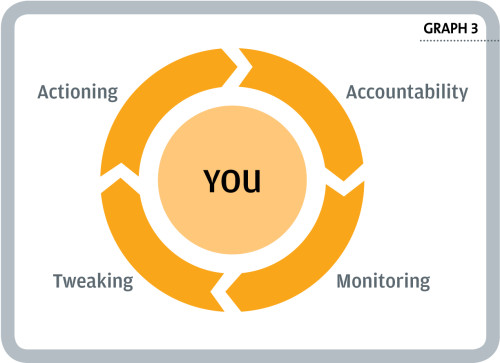Mindfulness In The Midst Of Madness

As you scan this page, some of you may think: “leadership in crisis” does not apply to me. Or does it? Firstly, what is a crisis? Let’s start with a dictionary definition of what a crisis is:
[crisis |krss|]
noun (pl.crises |-siz| )
- a time of intense difficulty or danger: the current economic crisis | [mass noun]: the monarchy was in crisis.
- a time when a difficult or important decision must be made: [as modifier]: the situation has reached crisis point.
- the turning point of a disease when an important change takes place, indicating either recovery or death.
We have all experienced a crisis at one point or another – whether personal, organisational or even communal. We may have different thresholds for it. So, how did we respond to it? As a victim or as a leader?
Crisis Can Be:
- Personal - When the difficulty befalls an individual, e.g. losing a job, failing an exam, choosing to start or end a relationship and a health scare.
- Organisational - When the situation affects a group of people, e.g. structural change, downsizing, exponential growth, deadlines for mission critical events, new manager, new team, relocation, and new markets or products.
- Communal - When the crisis has national or international ramifications, e.g. the recent MH370 and MH17 incidents had personal, organisational and community consequences.
Whatever the outcome, as the crisis passed and the intense difficulty ends, two things are certain:
- You always had to make an important decision. You can surrender to the situation, abdicate responsibility, or just do nothing (i.e. inaction is still a decision).
- An important change would have occurred, i.e. recovery to a better order of things, or “kiss of death” scenario. Nothing is as it was before the event (refer to Graph 1 below).

So, the next time a crisis looms, how would you like to choose this decision instead: step up and face chaos, volatility and uncertainty head-on as a leader. Have an active stake in the transformation that occurs as a result. The bonus? You will undoubtedly learn something in the process. If you are still in the midst of a crisis, take this as a turning point. Be a leader.
What is a Leader?
A leader is somebody with a clear idea of a compellingly better future that s/he can engage and excite us towards. S/he possesses the exceptional energy to persist against all odds and resistance to get us there. Leaders can be in the context of home, work or community. Leadership is not about your position, but it is the relationship you foster.
For example, when I am at a loss with my computer - inevitably we all have our “technology crisis leader” at home – my son has often stepped up to lead me out of it! Now that you have decided to BE A LEADER in crisis. What are the core basics you need to equip yourself with?
In a recent assignment over the past two years – wrought with daily crises to avert or work through – I had the privilege to support a senior management team of an airline, as they transitioned their operations to their new hub in the Middle East. This was amidst complex circumstances beyond their control and that caused several delays to the opening first scheduled in 2008. The frustration of this experienced team of talented individuals was palpable. They were eminent leaders in their own right.
Thrown into the mix: cultural diversity, extensive range of stakeholder needs, extreme climate conditions and intricate politics, their extreme stress meant extraordinary measures. We worked on their mindfulness in the midst of madness: energising while staying calm, stretching their comfort zone to more agility in the head, heart and hands, and to awaken their latent genius and emotional resilience in themselves as well as their extended teams.
When the airport went fully operational on 27 May 2014, the executive VP, a veteran of multiple international airport openings, commented “it was the smoothest airport opening in history”, and the CEO praised it as a “relatively flawless transition” to the rest of the organisation (refer to Graph 2 below)
Here are the essentials that helped evolve these leaders out of extreme stress. Exercise extreme self-care.
Don’t…
- panic
- resist change
- blame
- fear
Do…
- eat nutritious foods
- get enough rest
- take constant breaks
- stay alert
- stay calm
- be mindful
- breathe, or inspire
When making crucial decisions, we need to think with a cool, calm and clear head. Let me invite you to do this exercise.
1 Inspiring Energy
To a count of six, breathe in through your nose. Then to another count of six, breathe out through your mouth, letting out the sound “ahhh” as you hold your hand to your heart. Repeat this cycle 10 times.
Over the next two minutes or so of this, I daresay you will feel inspired to think clearer and feel calmer. Don’t take my word for it. Try it! There are more ways of harnessing your energy (rather than managing the stress) for more resilience. Yet this is by far the quickest, easiest and most effective which gives you the edge.
2 Count Your Blessings
Another one is to keep a Gratitude Journal. One can write, or do an audio/video recording on our smart devices. Review random pages when feeling a little less than inspired. I’d be surprised if you have no new insights.
3 Agile to Act in Adversity
You need to take action. You have to engage energy not only for yourself but those you lead. You must excite external entities out of their inertia. In a crisis you have to make do with what you have. Whatever is on hand to use, whoever is on your team to deploy, and time is the essence. You need to tune in your five senses so they are at peak performance.
A mentor of mine once defined ‘the Sixth Sense’ as the heightened synergistic use of all our five senses. You need to amplify whatever assets you have at your disposal. You do this with three E’s below:
- Engage your followers – whether they are your teammates, family, or countrymen. Build trust by showing them you understand what dire straits we are in if we do nothing. Salt the wounds. The pain will fuel a move away from “now”.
- Explain to them that there is a way out if we keep cool, calm and clear heads. Start with the inspired breathing exercise above. Assure them that there is a place for each of us to help – no matter how minor. We need all the help we can get. What can they contribute?
- Excite them with a hopeful clear compelling desired future. The greater the dissonance in expectations from the “now”, the greater the energy and motivation for movement.
Everyone has something of value to add. The time will come for them to know when to step up. We can’t do it alone. As a leader in crisis, you will dance between a calm energising ‘balcony’ view away from the ‘battlefield’ and back, to excite your team to act with agility through adversity so that you can together achieve impossible missions and reap extraordinary results. Bounce back better and bolder. With some volatile ‘storms’, unchartered territory is eminent. No prior track of success nor a viable plan is obvious. All concerned need to sharpen their “sixth sense” and lose their (usual) minds to execute on decisions with insufficient information.
Albert Einstein used to say that any problem cannot be solved at the same level of thinking that created it. We need to change our thinking to get out of such impasse so we can chart new territories of innovation. Since two heads are better than one, and many hands make light work, it is time to cooperate to create a culture of co-learning by:
- Co-creating a compelling future
We are more likely to get buy-in from everyone. This also gives a more holistic perspective. It engages head and heart.
- Co-diagnosing the current reality
Getting all to take stock of the ‘pain’ in the “now” will create more energy to drive to a desired future. Brainstorm how to get away – no judgment or editing of ideas that come up. That’s our action plan.
- Champion by choice
Choose an idea you feel passionate to lead out on from the Action Plan. Everyone to step up to significance and take turns to lead.
- Collaborating
Brainstorm and make decisions on priorities and KPIs (key performance indicators) in the short term. Choose when to be a leader or a follower, and take action.
- Calibrating the ongoing situation
So it goes for each one – a journey for which you are accountable. You need to constantly monitor your behaviour, your actions and your thoughts. Ask others what your leadership is like. Look for feedback. Then adjust what you do. Keep taking action – and ask those who’ve given you feedback what they’ve noticed (refer to Graph 3 below).
- Coach one another
Listen, observe, give feedback, agree on actions, test, debrief and learn.
- Cycle back
Get into the rhythm of checking back on co-creating, co-diagnosing, collaborating, calibrating, coaching and cooperating towards a better desired future.
“I’m passionate about fostering design thinking, visual collaboration and team creativity. … I believe the marshmallow challenge is among the fastest and most powerful technique for improving a team’s capacity to generate fresh ideas, build rapport and incorporate prototyping – all of which lie at the heart of effective innovation.” – Tom Wujec, Fellow at Autodesk, world leader in 2D & 3D technology
Committing to collaborate on a laboratory of learning partnerships drawing from Design Thinking (Design Thinking Process from d-school Stanford University 2012) to Prototyping (Prototyping for Team Creativity) to co-diagnose, co-design, co-develop and co-operate regardless of rank in the fast-moving organisation where supernormal results are expected which demands extraordinary energy. It is about working with a coaching and consultative style to allow the best talent of each member to show up in the relevant moment.
As they say: All for one, one for all!
It is a culture of continuous co-learning where growing through a crisis becomes the new normal. It strengthens us rather than breaks us down. It helps us get ‘unstuck’ through partnering, and so releases us to bounce back better and bolder every time.
“The best way to predict the future is to create it.” – Peter Diamandis, CEO and chairman of the X-Prize
“The future is not a place that we are going. It is a place we are making.” – John Schaar, futurist
So, let’s make a future where crisis is the cradle of creativity! Your ABCDE Checklist in Crisis:
- Amplify your available assets
- Agile to act in adversity
- Bounce back better and bolder
- Being on the brink brings benefits
- Count your blessings
- Courage to commit, collaborate & co-create
- Don’t despair during distress
- Don’t defer development
- Exercise extreme self-care
- Engage energy to evolve everyone
Dr Yvonne Sum currently spearheads a team with cultural diversity, breadth of capability and depth of experience to support accelerated leadership development at all levels with a specific focus on high performing teams. To engage with her, email us at editor@leaderonomics.com.
Functional
Tags: Stress & Trauma, Growth Mindset, Mindfulness, Understanding Emotions, Creativity





